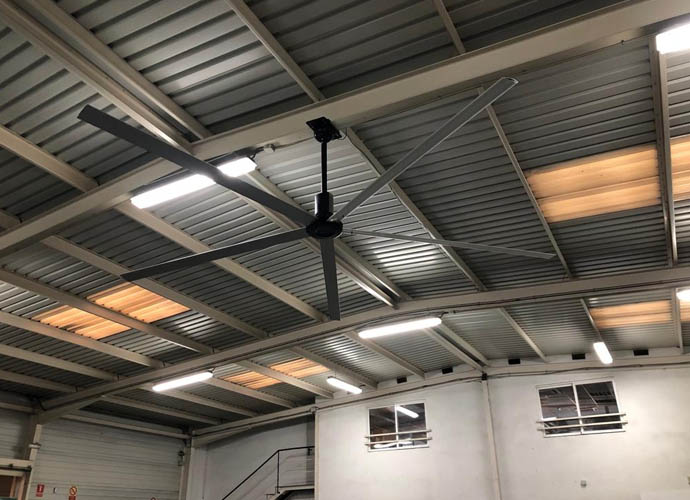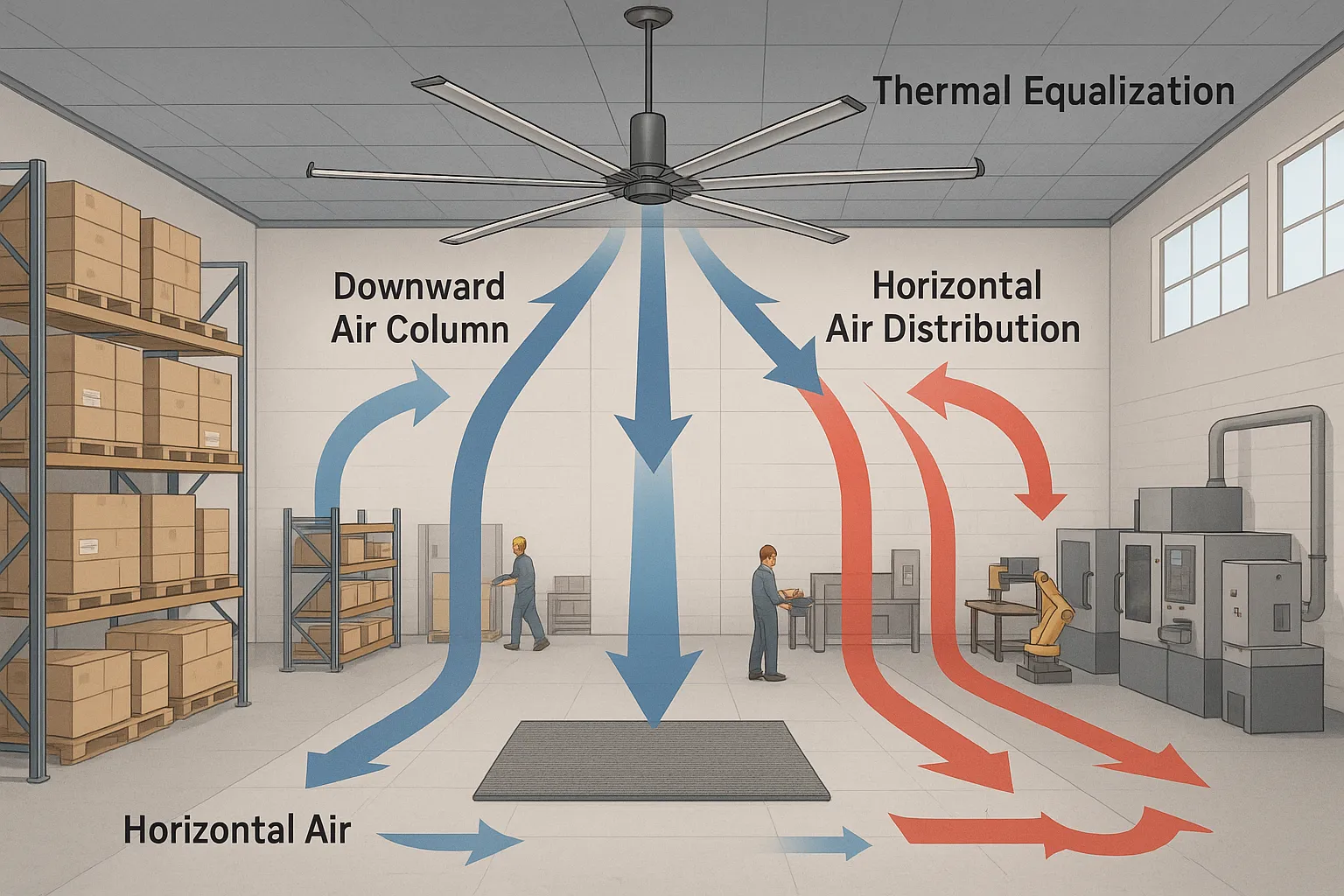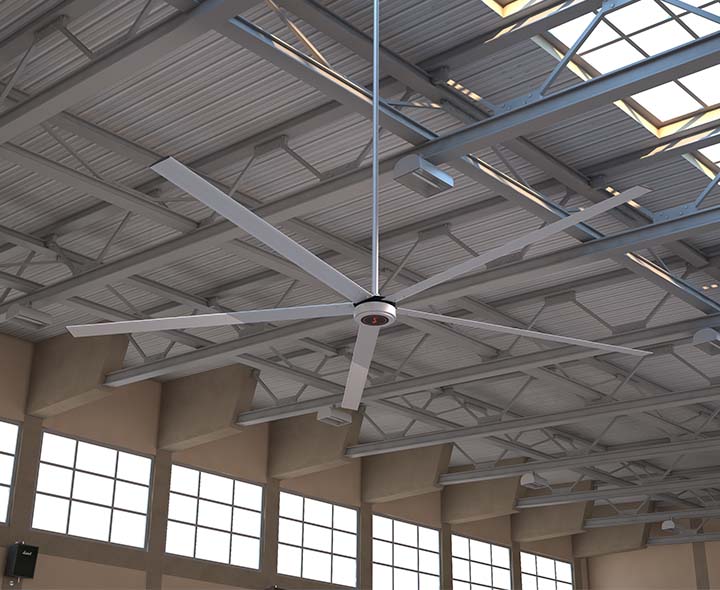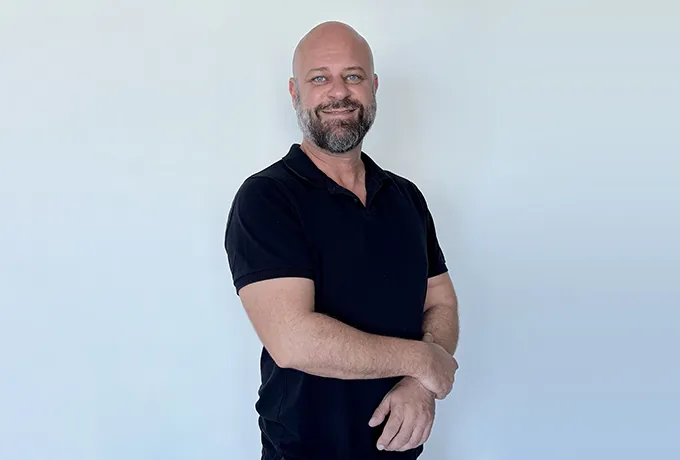Too hot in summer, freezing in winter, and stuffy air all year round? Many factories and warehouses lose productivity and rack up high energy bills simply because they lack the right airflow. The answer: an industrial ceiling fan designed for big, challenging spaces.
An industrial size ceiling fan—also called an HVLS (high-volume, low-speed) fan—is a powerful ceiling fan engineered for large commercial and industrial spaces. These fans move huge volumes of air, stabilize temperature, cut energy costs, and improve comfort across thousands of square feet.

industrial ceiling fan for factory warehouse
Not Your Ordinary Ceiling Fan
Most homes use ceiling fans for local comfort. But in factories, warehouses, and gyms, traditional fans simply can’t handle the demands of industrial and commercial environments. This is where industrielle Deckenventilatoren shine.
“Industrial ceiling fans are designed to handle the unique air circulation challenges in large commercial and manufacturing facilities, ensuring a safer and more productive work environment.”
Vergleichstabelle:
| Besonderheit | Home Ceiling Fan | Industrieller Deckenventilator |
| Typical Blade Span | 3–5 ft | 8–24 Fuß |
| Motor Typ | AC/DC, low power | Heavy-duty, VFD/EC/DC |
| Airflow Coverage (sq ft) | 150–400 | 2,000–30,000+ |
| Maintenance Needs | Niedrig | Low (with periodic checks) |
| Operating Hours | Intermittent | Kontinuierlich |
| Typical Application | Living Room, Office | Factory, Warehouse, Gym, Barn |
Explore industrial solutions:
See real applications at industrielle Deckenventilatoren für die Fertigung Und Lager HVLS-Ventilatoren.
In large industrial and commercial spaces, stagnant air is a common problem—especially in high-bay warehouses and big factories with complex layouts.
How HVLS Fans Work:
Airflow Chart:
| Lüfterdurchmesser | Typical Coverage Area | Beste Anwendung |
| 2,4–3,6 m | 2,000–6,000 sq ft | Small warehouses, gyms, barns |
| 14–18 Fuß | 6,000–15,000 sq ft | Large warehouses, manufacturing |
| 20–24 Fuß | 15,000–30,000 sq ft | Airports, logistics, sports centers |

warehouse airflow chart
Die richtige Wahl Industrieller Deckenventilator size is crucial for maximizing air movement and energy efficiency. The choice depends on your building’s square footage, ceiling height, layout complexity, and even the type of work environment.
Quick Reference Table:
| Raumtyp | Typical Ceiling Height | Recommended Fan Size | Air Coverage (sq ft) |
| Small Warehouse | 14–18 Fuß | 2,4–3,6 m | 2,000–6,000 |
| Mid-size Gym | 16–25 ft | 12-16 Fuß | 6,000–12,000 |
| Large Manufacturing | 20–40 ft | 16–24 ft | 12,000–30,000+ |
Tipp:
For buildings with obstructions or unique layouts, use a mix of Richtungsventilatoren and large ceiling fans for the best air movement solutions.
HVLS-Deckenventilatoren go far beyond traditional fans in delivering comfort and savings for industrial and commercial spaces.
Fallstudie:
A leading logistics warehouse installed six 20-foot HVLS fans. Within three months, worker complaints about heat dropped by 90%, and monthly energy bills fell by 28%. Maintenance teams reported less dust buildup and improved air quality, supporting a safer work environment.
Energy efficiency is a major driver for industrial and commercial ceiling fan adoption.
How do these fans save money?
Real-World Data Table:
| Art der Einrichtung | Energy Cost Reduction | Fan Quantity | Abdeckungsbereich |
| Warehouse (100,000 sf) | 25-30% | 6 | 100,000 sq ft |
| Food Processing Plant | 22% | 4 | 50,000 sq ft |
| Sports Complex | 18% | 3 | 36,000 sq ft |
Want to see more numbers?
Compare models and see detailed data at beste HVLS-Ventilatoren.
Selecting the best industrial ceiling fan means balancing performance, efficiency, durability, and site-specific needs.
Measure Your Space:
Calculate square footage (length x width) and note the ceiling height.
Assess Obstructions:
Columns, racks, or machinery may affect airflow—plan accordingly.
Choose Fan Options:
Consider Motor Type:
DC motor ceiling fans offer higher efficiency and quieter operation.
Select Features:
Suche nach variable Geschwindigkeit, integrated LED, heavy-duty materials, and relevant certifications.
“The right industrial fan is an investment in workplace comfort, safety, and operational savings. Consult with HVLS specialists to optimize your solution.”
For tailored advice, explore hvls ceiling fans for warehouse oder fans for commercial buildings.

How to Choose the Right Ceiling Fan for Your Facility
Choosing between a DC motor ceiling fan and a traditional AC motor is now a key decision for industrial and commercial buyers.
Vergleichstabelle:
| Besonderheit | DC Motor Ceiling Fan | AC Motor Ceiling Fan |
| Energieaufnahme | Niedrig | Moderate–High |
| Geräuschpegel | Sehr niedrig | Mäßig |
| Kontrolle | Variable Speed, Remote | Basic (Step or Pull) |
| Wartung | Minimal | Mäßig |
| Kosten | Higher upfront | Lower upfront |
| Langlebigkeit | Longer | Shorter |
For high-volume, low-speed (HVLS) fans, DC is the gold standard for efficiency, especially in 12 foot and 16 foot industrial fans.
Even the most robust industrielle Deckenventilatoren need some basic care for peak performance and longevity.
“Most HVLS fans are designed for low maintenance, but routine checks help deliver powerful, quiet operation for years—improving ROI and reducing surprises.”
Resource:
Maintenance tips for various models can be found at industrial fans direct.
Not all industrial fans are created equal!
The best fans for commercial and industrial spaces offer a blend of durability, flexibility, and safety.
For full feature details, visit HVLS-Ventilatoren Und verzinkter hängender Deckenventilator.
Absolutely!
Modern large ceiling fans blend powerful performance with stylish, industrial aesthetic.
Explore real-life installations:
Check out große gewerbliche Deckenventilatoren für gewerbliche Gebäude.
Client:
A global e-commerce fulfillment center, 120,000 sq ft, 28-foot ceilings.
Challenge:
Rising summer temperatures caused worker discomfort, equipment overheating, and a spike in cooling costs. Stagnant air also led to condensation on warehouse floors, increasing safety risks.
Solution:
The facility installed eight 20-foot HVLS fans, each equipped with integrated LED and variable speed controls.
Results After 3 Months:
Key Insight:
“Installing HVLS fans was one of the fastest ways to boost both comfort and cost savings in our entire operation. The change was immediate and noticeable.”
How do industrial ceiling fans improve air quality?
They keep air moving continuously, reducing humidity, preventing mold and rust, and helping to remove airborne dust and fumes.
Can HVLS fans be installed in existing buildings?
Yes. Most are designed for easy retrofit with adjustable mounting brackets and various downrod lengths.
Are HVLS fans loud?
No. Modern HVLS fans deliver quiet operation even at maximum speed—typically less than 50 dB at ground level.
How many fans do I need for my facility?
It depends on size, ceiling height, and obstructions. One 20-foot HVLS fan can often replace dozens of small barrel fans or directional fans. Consult a professional for a custom plan.
Can I control several fans at once?
Yes. Centralized remote or wall panels let you control speed, direction, and lighting for multiple fans.
What is the lifespan of an industrial ceiling fan?
With regular maintenance, quality HVLS fans often last 12–15 years or more.
Are outdoor ceiling fans available for barns and gyms?
Absolutely. Choose outdoor-rated models designed to withstand moisture, dust, and temperature changes.
Do fans require regular maintenance?
Minimal, but regular inspections and cleaning are recommended for safe, reliable operation.
Do HVLS fans help in winter?
Yes. By mixing warm air from the ceiling down to the floor, they make heating more efficient and comfortable.

Hallo, ich bin Michael Danielsson, CEO von Vindus Fans, mit über 15 Jahren Erfahrung in der Ingenieur- und Designbranche. Ich bin hier, um mein Wissen weiterzugeben. Wenn Sie Fragen haben, können Sie mich jederzeit kontaktieren. Lassen Sie uns gemeinsam wachsen!